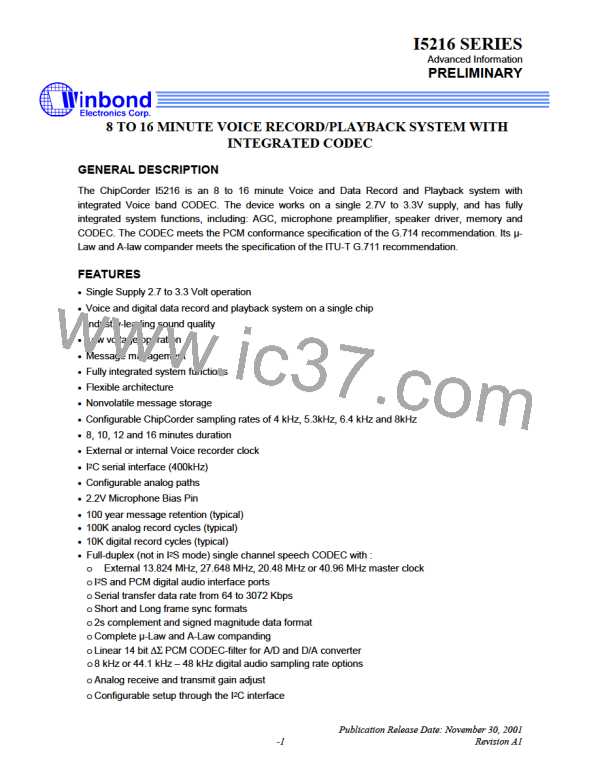I5216 SERIES
Advanced Information
PRELIMINARY
2. Power up the LOW PASS FILTER—Bit FLPD controls the power up state of the LOW PASS
FILTER stage. This is bit D1 of CFG1 and it must be set to ZERO to power up the LOW PASS
FILTER STAGE.
3. Select the 8.0 kHz sample rate—Bits FLD0 and FLD1 select the Low Pass filter setting and sample
rate to be used during record and playback. These are bits D2 and D3 of CFG1. To enable the 8.0
kHz sample rate, D2 and D3 must be set to ZERO.
4. Select the LOW PASS FILTER input (only) to the S2 SUMMING amplifier —Bits S2M0 and S2M1
control the state of the SUM2 SUMMING amplifier. These are bits D5 and D6, respectively, of
CFG1 and they should be set to the state where D5 is ZERO and D6 is ONE to select the LOW
PASS FILTER (only) path.
5. Select the SUM2 SUMMING amplifier path through the VOLUME MUX—Bits VLS0 and VLS1
control the VOLUME MUX stage. These bits are D14 and D15, respectively, of CFG1. They should
be set to the state where D14 is ONE and D15 is ZERO to select the SUM2 SUMMING amplifier.
6. Power up the VOLUME CONTROL LEVEL—Bit VLPD controls the power-up state of the VOLUME
CONTROL attenuator. This is Bit D0 of CFG0. This bit must be set to a ZERO to power-up the
VOLUME CONTROL.
7. Select a VOLUME CONTROL LEVEL—Bits VOL0, VOL1 and VOL2 control the state of the VOL-
UME CONTROL LEVEL. These are bits D11, D12, and D13, respectively, of CFG1. A binary count
of 000 through 111 controls the amount of attenuation through that stage. In most cases, the
software will select an attenuation level according to the desires of the product user. In this
example, we will assume the user wants an attenuation of –12 dB. For that setting, D11 should be
set to ONE, D12 should be set to ONE, and D13 should be set to a ZERO.
8. Select the VOLUME CONTROL path through the OUTPUT MUX—These are bits D3 and D4,
respectively, of CFG0. They should be set to the state where D3 is ZERO and D4 is a ZERO to
select the VOLUME CONTROL.
9. Power up the SPEAKER amplifier and select the HIGH GAIN mode—Bits OPA0 and OPA1 control
the state of the speaker (SP+ and SP–) and AUX OUT outputs. These are bits D1 and D2 of
CFG0. They must be set to the state where D1 is ONE and D2 is ZERO to power-up the speaker
outputs in the HIGH GAIN mode and to power-down the AUX OUT.
10. Power up the Internal Oscillator—Bit OSPD controls the power up state of the Internal Oscillator.
This is bit D8 of CFG0 and it must be set to ZERO to power up the Internal Oscillator.
To set up the chip for Memo or Call Playback, the configuration registers are set up as follows:
CFG0=0010 0100 0010 0010 (hex 2422).
CFG1=0101 1001 1101 0001 (hex 59D1).
CFG2=0000 0000 0000 0011 (hex 0003).
Only those portions necessary for this mode are powered up.
Publication Release Date: November 30, 2001
- 33
Revision A1

 WINBOND [ WINBOND ]
WINBOND [ WINBOND ]